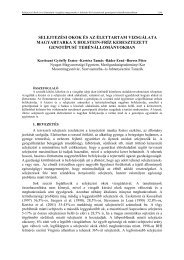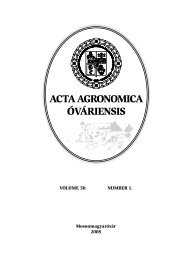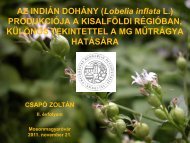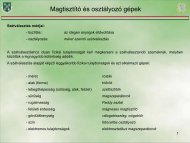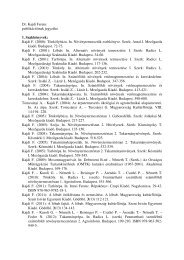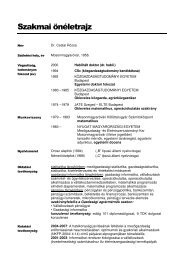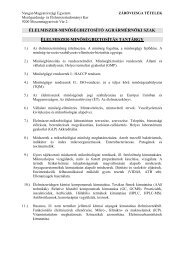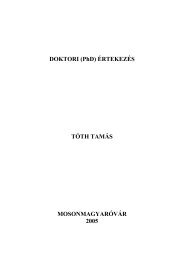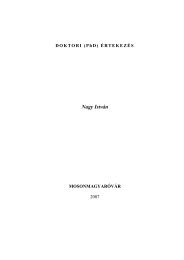teljes anyag - Nyugat-Magyarországi Egyetem Mezőgazdaság
teljes anyag - Nyugat-Magyarországi Egyetem Mezőgazdaság
teljes anyag - Nyugat-Magyarországi Egyetem Mezőgazdaság
Create successful ePaper yourself
Turn your PDF publications into a flip-book with our unique Google optimized e-Paper software.
54N. Varga – E. Bertalanné Várallyay – L. Salamon:is suitable for Hungarian circumstances to trace economic losses caused by the diseaseincluding production and price data. The yearly average loss caused by BVD is around630 million HUF, but if the volume of infection is higher its impact is higher too, so it mayexceed 1 billion HUF. Regarding the stock we should calculate with 1600 HUF highercosts per cow per year. Costs mainly derive from calve and young stock mortality. Acuteinfections indicate a loss of about 1 billion HUF in a herd of 1000 cows. A summary ofcosts generated by the virus show the rate of income that could be achieved if the stockwere virus free (Ózsvári et al. 2001b).Bovine Infectious Rhinotracheitis (IBR)IBR is a respiratory disease of young cattle and is spread world wide and causes considerablelosses mainly in large scale keeping. According to the publications 80% of the stockof large scale farms are infected, however the stock of small dairy farms is less infected,only 15%. According to the data of HCOS (Hungarian Central Office of Statistics) therewere 490,000 infected animals and 438 out of them were calves and young stock in 1989.Losses caused by the disease exceeded 3 billion HUF per year in the country, which wasmore than 14,000 HUF calculated on one infected cow in 1999. It is a result of prematureculling of calves and young stock. Yearly loss of a dairy farm with 1000 cows comesaround 14 million of HUF owing to sub-clinical IBR and 34 million of HUF owing toclinical IBR (Ózsvári and Bíró 2001).MATERIAL AND METHODIn our investigations we aimed to answer the questions: ”What are the most frequent diseasesin dairy herds in the West-Transdanubian Region” and ”How high was the rate ofculling in the same region in 2002”. Data were collected after handing out questionnairesto 30 dairy farms. The questions were about the health situation of the stock. In 5 out of theinvestigated farms cows were kept in boxes and in 25 they were kept unbound in barns andoutdoor with floor management. Each farm had a fodder mix plant and most of the themused herringbone milking systems, but there were parallel, standing or pipe-lined types,too. 21 farms used Alfa-Laval systems. Farms were leucosis free and IBR-immunisationwas going on at the time of the investigation.RESULTS AND CONCLUSIONTable 1. show the health situation of the dairy herds.Outraging is dairy farm No. 24, because the calving interval period was 90–100 dayslonger than the farms average. Dairy farmers explained it with fat-mobilisation problemsand high rate of infertility.




